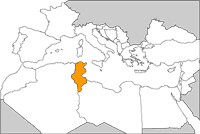 |
National Parks
- Bou-Hedma
- Boukornine
- Chambi
- Djebel Sahara
- El-Feidja
- Ichkeul
- Sidi Toui
- Tabarka
- Zembra and Zembretta
Natural Reserves
- Ain Chrichira
- Aina Zana
- Complexe des Iles Kneiss
- Dgebel Serj
- Djebel Bouramli
- Djebel Khroufa
- Djebel Touati
- Etella
- Grotte de Chauve souris d'El Haouaria
- Ile Chikly
- Kechem el Kelb
- Lac de Tunis
- Majen Djebel Chitane
- Sebkhat Kelbia
- Tourbière de Dar. Fatma
Nature Reserves
- Cap Bon peninsula
- Chott el Fedjadj
- Dar Fatma
- Djebel Bargou
- Djebel Marchana
- Djebel Mrhilla
- Djebel Ousselat
- Djebel Ressas
- Djebel Selloum
- Djebel Serdj
- Djebel Zaghouan
- Golfe de Bou Grara
- Grotte de Chauves Souris d'El Haouaria
- Iles Kouriates
- Kerkennah isles
- Kneiss islands and the Gulf of Gabes mudflats
- Lac Bizerte
- Lac de Radès et Salines
- Medjerda Estuary
- Nefta oasis
- Sebkhet Sidi Mansour
- Tourbiere de Dar Fatma
Reserves
Marine Reserves
Wildlife Reserves
- Ain Baccouch
- Dar Chichou
- M'hibeus
- Orbata
Bird Reserves
Other Protected Areas
- Dghoumes
- Iles de Djerba
- OM. Chieh
- Sebkhat El Khalij (Golfe de Gabès)
- Tunis Botanic Garden
Wetlands of National Importance
- Bahira El-Bibane
- Chott El Djerid
- Iles Kneiss et vasières du Golf
- Lac de Rades et Salines
- Salines de Thyna
- Sebkha Halk el Menzel
- Sebkhet Ariana
- Sebkhet El-Djem
- Sebkhet es Sedjoumi
- Sebkhet Kelbia
- Sebkhet Kourzia
- Sebkhet Sedjoumi
- Sebkhet-Sidi-El-Hani
Wetlands of International Importance (Ramsar)
World Heritage Convention
- Amphitheatre of El Jem
- Dougga / Thugga
- Ichkeul National Park
- Kairouan
- Medina of Sousse
- Medina of Tunis
- Punic Town of Kerkuane and its Necropolis
- Site of Carthage
UNESCO-MAB Biosphere Reserve
- Parc national de Djebel Bou-Hedma
- Parc national de Djebel Chambi
- Parc national de l'Ichkeul
- Parc national des Iles Zembra et Zembretta
Barcelona Convention
- Galiton
- Ichkeul
- Ile Chikly
- Iles de Kneiss
- Zembra et Zembretta
|
Protected Areas in Tunisia
The main goals of Tunisian environmental policy are the conservation of ecological balance, of natural and human resources and the fight against all forms of pollution. Moreover, the Tunisian environmental policy aims at matching the requirements of progress and development with the environmental protection strategy of reducing risks threatening natural resources (air, water, soil, biodiversity) and improving the living conditions of the population. These goals are defined within a national strategy for sustainable development, according to the principles of the World Conference in Rio in 1992.
Among the institutions dealing with nature protection in Tunisia, the leading role is played by the Ministry of Agriculture and Water Resources, which is responsible for the planning and implementation of a national environmental policy.
Sources: World Database on Protected Areas
|
|


